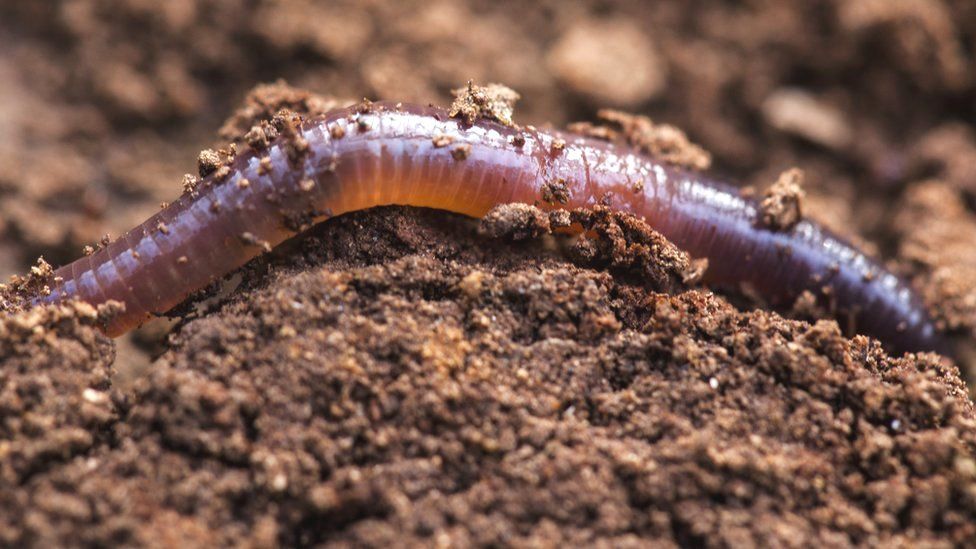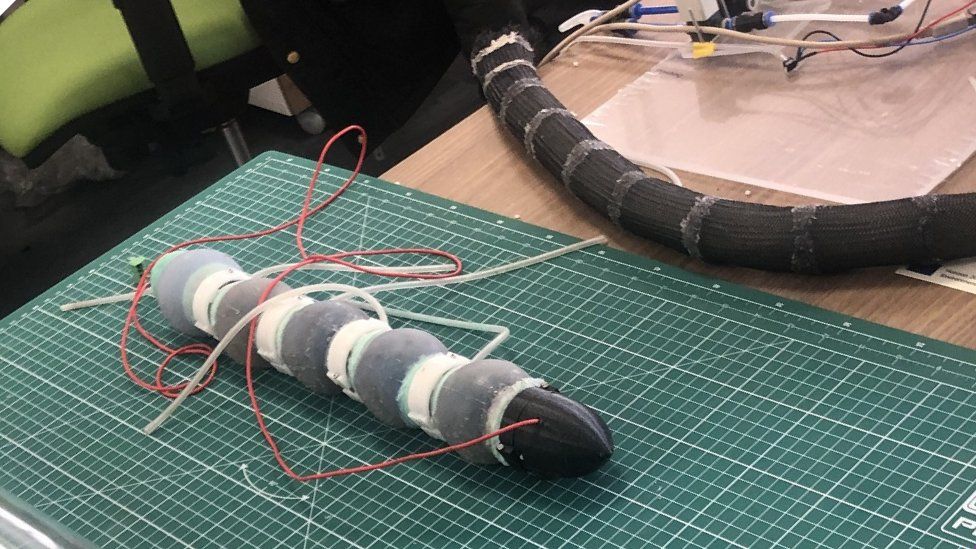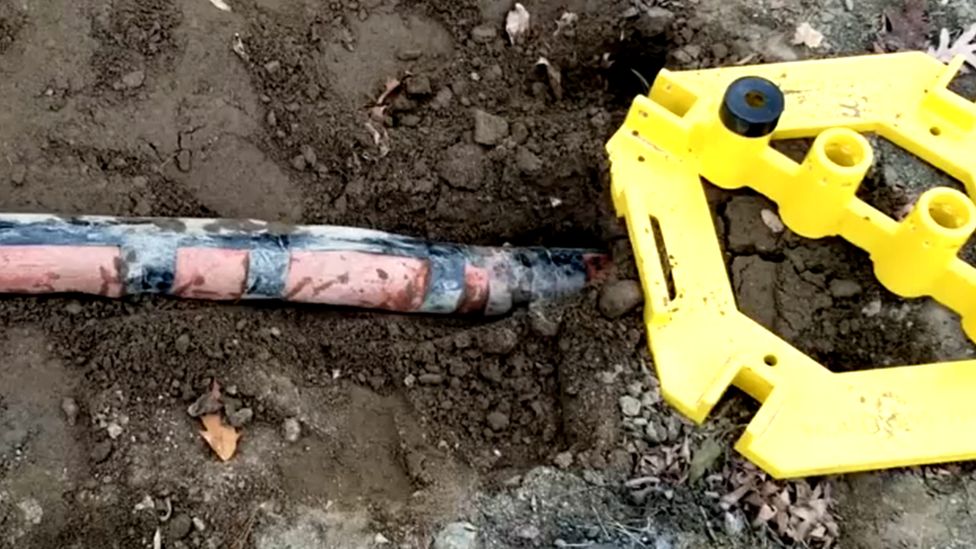Why robotic worms could one day dig beneath your feet

For decades, scientists have been developing soft robots inspired by a creature often taken for granted – the humble earthworm.
Though specific features will vary by species, many earthworms are excellent burrowers, and can bend with ease.
“They are very flexible and move through spaces that might be difficult to access,” comments Elsa Arrázola-Vásquez, who researches soil management at the Swedish University of Agricultural Sciences.
In other words, earthworms can do things that many machines still cannot.
The progress in replicating these functions robotically has been incremental. There have been innovations in mimicking earthworm setae (bristles), which help worms to anchor. Plus, there’s been progress copying the fluid in their segments which, among other functions, help them to move.
Capturing the distinctive movement of the earthworm is the latest advance.
In the Soft Robotics group at the Italian Institute of Technology (IIT), researchers have developed a robot that essentially bulges in and out at the sides while it stretches and contracts in length.
This design is novel, according to Riddhi Das, a mechanical engineer at IIT, as it uses positive and negative pressure to generate force which is directed outwards and along the length of the robotic worm.
The innovation means his creation more closely represents how an earthworm’s muscles move, and allows for more varied movement.
His earthworm robot is about the length and weight of a light dumbbell. It’s filled with gel which allows the researchers to better approximate the earthworm’s radial movements, compared to other types of liquid. And though it’s not as fast on a flat surface as some previous designs, it’s able to move deeper through artificial soil.

One person who knows how hard it is to build an earthworm-type robot that can burrow is Yasemin Ozkan-Aydin, an electrical engineer at the University of Notre Dame in the US.
She has worked on four earthworm robot designs, drawing on observations of real earthworms.
She says the IIT group’s innovation is “very important” in the world of robotics, as each segment of their earthworm robot has the capability to expand in two directions. That allows it to create an earthworm-type locomotion, which is like a wave of contraction and expansion that moves along its body.
Like the other projects in her lab at IIT, this is genuinely bioinspired, says biologist-turned-roboticist Barbara Mazzolai. This means that developing the prototype required a fundamental understanding of earthworm biology, rather than just mimicking its shape.
And those biological principles had to bring some useful function to the robot. In the case of bioinspired earthworm robots, one useful aspect to replicate is an earthworm’s soft yet strong structure.
One key difference remains the size. With a diameter of 4cm and a length of 45 cm, the IIT robot is considerably larger than an actual earthworm. Earthworm robots typically have pumps or other systems for movement that add to their bulk. This limits the potential applications in endoscopy (the use of tubes to examine internal organs).
Still, this robot isn’t as big as the rugged tunnelling robot created by the multinational company GE, one of the few earthworm robots being developed for near-term commercial applications.

It’s a self-propelling, extremely flexible, highly steerable robot, according to Deepak Trivedi, a mechanical engineer at GE Research.
“If you look at the basic building blocks of these robots, these are pneumatic artificial muscles, which are essentially rubber with a cleverly designed fibre mesh around it,” Mr Trivedi explains.
This research line was inspired by a call for tactical tunnelling solutions from the Defense Advanced Research Projects Agency (Darpa) in the US.
“Earthworms can do this tunnelling in a very stealthy way,” Mr Trivedi points out. While that Darpa programme has now ended, GE is continuing to work with the US Department of Defense on specific use cases in tunnelling and navigating.
They are also seeking out commercial clients. Their robot, which has a diameter of about 10cm, is unusual in being able to create its own tunnels and having been tested in real soil of different types.


The GE researchers believe that it would be useful for installing underground utility infrastructure, in a less environmentally damaging manner than some conventional drilling. They’re aiming for a lower cost as well.
“We see a real commercial opportunity for this,” says John Lizzi, who leads the Robotics and Autonomous Systems division at GE Research. He believes key areas include fibre internet, electrical power and charging infrastructure for electric vehicles.
However, GE is limited in what it can publish and publicly disclose about this research, given the military funding. And of course not every roboticist wants to work towards military applications.
Apart from those, eventually earthworm-like robots could also be applied in areas like mining, agricultural sensing, and planetary excavation.
An especially important use could be in search-and-rescue. Prof Ozkan-Aydin talks of the recent earthquakes that devastated Turkey, her country of origin. A tiny wriggling robot with a camera attached could have been useful there for determining where to concentrate rescue efforts, without disturbing the ground.
But plenty of research will need to be done first. Certain essential features of earthworm biology – like the mucus they secrete to lubricate their passage through soil and keep themselves from drying out – are challenging to incorporate into a robot.
“Because it’s a natural system and it has evolved for so many years, it’s very difficult to replicate,” acknowledges Mr Das of IIT.
So nobody is going to mistake one of these robots for a living earthworm. And some people have been overly optimistic about bioinspired systems in the past.
“I’m a bit disappointed that more artificial muscle technology hasn’t made it across the ‘R&D valley of death’,” admits Kellar Autumn, a biologist at Lewis & Clark College in the US.
Like his work on gecko-inspired adhesives, he believes that artificial muscles are following the “10/10 rule of innovation” – 10 years to discover, and another 10 to reach a market.
If these earthworm-inspired robots do eventually reach a market, they could someday be tunnelling away beneath our feet, helping to lay down the equipment that keeps our societies functioning.
